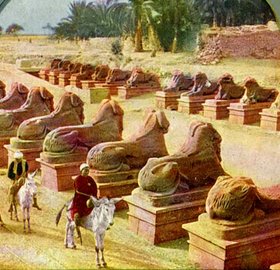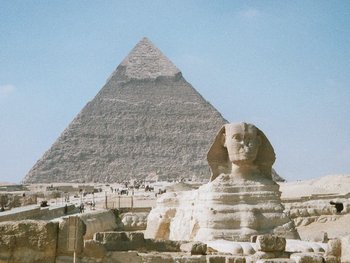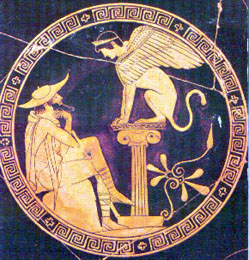Sphinx
|
|
- See also Sphinx (disambiguation)
A Sphinx is an iconic image of a recumbent lion with a human head, invented by the Ancient Egyptians of the Old Kingdom, but a cultural import in archaic Greek mythology, where it received its name (Greek Σφιγξ, "strangler").
| Contents |
Egyptian sphinx
The Egyptian sphinx is an ancient iconic mythical creature usually comprised of a recumbent lion – an animal with sacred solar associations – with a human head, usually that of a pharaoh.

The largest and most famous is the Great Sphinx of Giza, which is on the Giza Plateau on the west bank of the Nile River, facing due east, with a small temple between its paws. The face of the Great Sphinx is believed to the head of the pharaoh Khafra (often known by the Hellenised version of his name, Chephren), which would date its construction to the Fourth Dynasty (2723 BC – 2563 BC). However, there are some alternative theories that re-date the Sphinx to pre-Old Kingdom – and, according to one hypothesis, to prehistoric – times.
Other famous Egyptian sphinxes include the alabaster sphinx of Memphis, currently located within the open-air museum at that site; and the ram-headed sphinxes, representing the god Amun, that line either side of the three kilometer route linking the complexes of Luxor Temple and Karnak in Luxor (ancient Thebes), of which there were originally some nine hundred.
What names ancient Egyptians called the statues is unknown. The Arabic name of the Great Sphinx, Abu al-Hôl, translates as "Father of Terror". The Western name "Sphinx" was given to it based on the legendary Greek creature with the body of a lion and the head of a lady, however the Egyptian Great Sphinx has the head of a man, and therefore the name is not technically accurate.
Greek Sphinx
There was one Sphinx in Greek mythology. She was a demon of destruction and bad luck, according to Hesiod a daughter of the Chimaera and Orthrus, according to others of Typhon and Echidna. She was represented most often seated upright rather than recumbent, as a winged lion with a woman's head; or she was a woman with the paws, claws and breasts of a lion, a serpent's tail and birdlike wings. Hera or Ares sent her from her Ethiopian homeland (for the Greeks remembered the Sphinx's foreign origins) to sit outside Thebes and ask all passersby history's most famous riddle: "Which creature in the morning goes on four feet, at noon on two, and in the evening upon three?" She strangled anyone unable to answer. The word "sphinx" comes from the Greek Σφιγξ, Sphinx, apparently from the verb σφιγγω, sphingo, meaning "to strangle". Oedipus solved the riddle: man – he crawls on all fours as a baby, then walks on two feet as an adult, and walks with a cane in old age. Bested at last, the Sphinx then threw herself from her high rock and died. In fact, the exact riddle asked by the Sphinx was not specified by early tellers of the story and was not standardized as the one given above until much later in Greek history.
Thus Oedipus can be recognized as a liminal or "threshold" figure, helping effect the transition between the old religious practices, represented by the Sphinx, and new, Olympian ones.
Similar creatures
Not all human-headed animals of antiquity are sphinxes. In ancient Assyria, for example, bas-reliefs of bulls with the crowned bearded heads of kings guarded the entrances to temples. In the classical Olympian mythology of Greece, all the deities had human form, though they could assume their animal natures as well. All the creatures of Greek myth that combine human and animal form are survivals of the pre-Olympian religion: centaurs, Typhon, Medusa, Lamia.
See also: shedu
Mannerist Sphinx
The revived Mannerist Sphinx of the 16th century is sometimes thought of as the French Sphinx. Her lovely coiffed head is erect and she has the pretty bust of a young woman. Often she wears eardrops and pearls. Her body is naturalistically rendered as a recumbent lion. Such Sphinxes were revived when the grottesche or "grotesque" decorations of the unearthed "Golden House" (Domus Aurea) of Nero were brought to light in early 16th century Rome, and she was incorporated into the vocabulary of arabesque designs that was spread throughout Europe in engravings during the 16th and 17th centuries. Her first appearances in French art are in the School of Fontainebleau in the 1520s and 30s; her last appearances are in the Late Baroque style of the French Régence (1715–1723). Sphinxes were too somber perhaps for the Rococo, and they tended to disappear from the European design repertory.
See also
da:Sfinks de:Sphinx (ägyptisch) fr:Sphinx id:Sphinx it:Sfinge nl:Sfinx ja:スフィンクス pl:Sfinks pt:Esfinge fi:Sfinksi sv:Sfinx uk:Сфінкс th:สฟิงซ์


